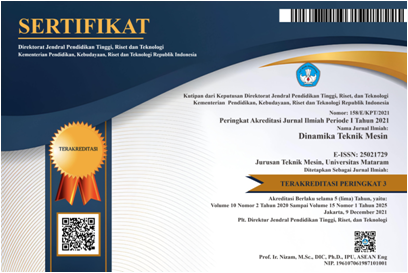The effect of variations in vulcan concentration in agel-cotton rope as a reinforcement for ripoxy composites on thermal conductivity properties
Abstract
Ripoxy composites reinforced with natural agel-cotton rope reinforcement have attracted attention in engineering material applications due to their mechanical properties and environmentally friendly waste. Vulcan chemicals, which are fillers or additives in the composite manufacturing industry, are believed to be able to improve the thermal properties of the composite. This study aims to examine the effect of vulcan chemical treatment on thermal conductivity in ripoxy composites reinforced with cotton rope. This test was carried out by soaking agel-cotton rope textiles in Vulcan solution for 1 hour with variations in solution concentration: 0%, 25%, and 50%. The printing of test specimens was carried out using a Vacuum Infusion printing tool, so that the printed specimen results were not contaminated by outside air. Thermal conductivity tests were carried out using the ASTM - D5470 standard. The test results that have been obtained, the 25% concentration variation has the smallest thermal conductivity value, with a value of 0.064 W / m°C at a temperature of 100° C and 0.171 W / m°C at a temperature of 200°C. Meanwhile, with a concentration variation of 50% the value increases because the greater the concentration of Vulcan given, the density of the composite material will increase, and higher concentrations can reduce the number of pores or voids in the composite which can usually inhibit heat flow.
Keywords
Full Text:
PDFReferences
Abidnejad, R., Baniasadi, H., Fazeli, M., Lipponen, S., Kontturi, E., Rojas, O. J., & Mattos, B. D., High-fiber content composites produced from mixed textile waste: balancing cotton and polyester fibers for improved composite performance, International Journal of Biological Macromolecules, 292, 2025.
Agirgan, M., Ahmet Ozgur, A., Taskin, V., Investigation of thermal conductivity and sound absorption properties of rice straw fiber/polylactic acid biocomposite material, Journal of Natural Fibers, 19(16), 15071–15084, 2022.
Alovsat, T. Y., Classification and properties of composites based on matrix material, World Journal of Advanced Research and Reviews, 24(02), 2278–2282, 2024.
Amran, Subaer, Husain., Produksi dan karakterisasi komposit ringan geopoplimer- serat gelas, Jurnal Sains dan Pendidikan Fisika (JSPF), 18(1), 101–110, 2022.
Azizi, R., Karakterisasi pengaruh orientasi serat terhadap sifat mekanis dan fisis komposit serat tandan kosong kelapa sawit, Jurnal Teknologi Rekayasa Teknik Mesin, 2(1), 28–35, 2021.
Bachtiar, E. V., Kurkowiak, K., Yan, L., Kasal, B., Kolb, T., Thermal stability, fire performance, and mechanical properties of natural fibre fabric-reinforced polymer composites with different fire retardants. Polymers, 11(4), 2019.
Caradonna, A., Badini, C., Padovano, E., Pietroluongo, M., Electrical and thermal conductivity of epoxy-carbon filler composites processed by calendaring, Materials, 12(1522), 1–17, 2019.
Dahal, R. K., Acharya, B., Dutta, A., Mechanical thermal and acoustic properties of hemp and biocomposite materials: a review, Journal of Composites Science, 6(12), 2022.
Diana, L., Ghani Safitra, A., Nabiel Ariansyah, M., Analisis kekuatan tarik pada material komposit dengan serat penguat polimer, Jurnal Engine: Energi, Manufaktur, Dan Material, 4(2), 59–67, 2020.
Farahmand, B., Understanding of composite materials (constituents of composites) bt - fundamentals of composites and their methods of fabrications: pmcs, mmcs, and cmcs, Springer Nature, Switzerland, 2025.
Julian, J., Pengembangan material komposit berpenguat serat alami untuk aplikasi bumper mobil, Jurnal Al Ulum LPPM Universitas Al Washliyah Medan, 10(2), 92–98, 2022.
Koronis, G., Silva, A., Fontul, M., Green composites: a review of adequate materials for automotive applications, Composites Part B: Engineering, 44(1), 120–127, 2013.
Madyaratri, E. W., Ridho, M. R., Aristri, M. A., Adly, M., Lubis, R., Iswanto, A. H., Nawawi, D. S., Antov, P., Kristak, L., Majlingov, A., Fatriasari, W., Recent advances in the development of fire-resistant biocomposites — a review, Polymers, 362(13), 2022.
Mahmuda, E., Savetlana, S., Sugiyanto, D., Pengaruh panjang serat terhadap kekuatan tarik komposit berpenguat serat ijuk dengan matrik epoxy, Jurnal Ilmiah Teknik Mesin, 1(3), 79–84, 2013.
Nguyen, T. A., Nguyen, Q. T., Hybrid biocomposites based on used coffee grounds and epoxy resin: mechanical properties and fire resistance, International Journal of Chemical Engineering, 2021.
Nisa, K. S., Melyna, E., Samida, M. R. M., Sintesis biokomposit serat sabut kelapa dan resin poliester dengan alkalisasi koh menggunakan metode hand lay-up, Rekayasa, 15(3), 354–361, 2022.
Pratama, N., Djusmaini, D., Yenni, D., Pengaruh variasi ukuran partikel terhadapnilai konduktivitas termal papan partikel tongkol jagung, Pillar of Physics, 7, 25–32, 2016.
Saleh, H. M., Dawoud, M. M., Introductory chapter: background on composite materials (H. M. Saleh & M. Koller (eds.)), IntechOpen, 2018.
Saputra, A., Samhuddin, S., Hasanudin, L., Perancangan dan analisis pengujian konduktivitas panas pada tipe material padat, Enthalpy : Jurnal Ilmiah Mahasiswa Teknik Mesin, 7(1), 22, 2022.
Sharma, A. K., Bhandari, R., Aherwar, A., Rimašauskienė, R., Matrix materials used in composites: a comprehensive study, Materials Today: Proceedings, 21, 1559–1562, 2020.
Song, J., Wang, G., Xing, L., Qian, J., Dai, L., Di, H., Influencing factors of rock thermal conductivity and applicability evaluation of its mixing law predictive models, Geothermics, 110, 2023.
DOI: https://doi.org/10.29303/dtm.v15i2.1097
Refbacks
- There are currently no refbacks.
Copyright (c) 2025 Open access

This work is licensed under a Creative Commons Attribution-NonCommercial 4.0 International License.






















